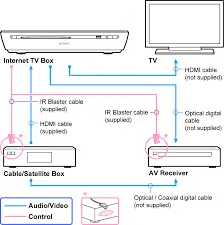If you own an older TV or a receiver that does not have an HDMI jack, there are still options available to connect it. This article will help you learn how to do it.
The first option is to use RCA audio cables. These cables include white and red lines that only transmit sound, so they’re a good alternative to HDMI for connecting your TV and receiver.
Table of Contents
RCA Audio Cables:
If your TV or receiver does not have an HDMI jack, you can still connect them together using RCA Audio Cables.
These cables are commonly available at most electronic stores at a reasonable price and are easy to install.
Generally, these cables come with two connectors: one for the left channel and one for the right channel. They are typically color-coded red and white for ease of wiring, but you can use them in any way you want to.
These RCA cables are made from premium quality RG-6/U cables with double copper braid shielding to prevent signal degradation cause by RFI and EMI interference. They are also available in a wide variety of lengths, which will suit most situations.
When it comes to connecting your audio and video equipment, the type of cable you use is vital for sound quality.
RCA audio cables offer a number of features that can enhance performance, including shielding and gold-plated connectors that are resistant to rust.
They are also durable and long lasting, making them the ideal choice for a wide variety of setups.
RCA Composite Video Cables:
If your TV or receiver does not have an HDMI jack, there are other options for connecting the two together.
You can use any RCA audio cable, a 5-cable component RCA video cable, or a composite video cable to connect the TV and the receiver.
These cables commonly use to connect a television or other device with a yellow RCA plug to a VCR, DVD player, or gaming system. They also have red and white RCA audio connectors on each end.
The red connector carries the right channel audio signal, while the white one carries the left channel audio signal. Generally, this type of cable is the easiest way to get the sound from your TV into your receiver without an HDMI jack.
It works with most TVs and receivers that have RCA inputs and outputs. But you should check the manual for your device to ensure it will work before purchasing.
Optical Cables:
Optical Cables, also known as TOSLINK cables, are another way to connect a TV and a receiver without HDMI. They’re made using optical fibers, which transfer digital audio data instead of copper wire.
Unlike wire, optical cables do not suffer from Electro-Magnetic Interference (EMI) – even when used with other types of electrical signals, like HDMI or DVI.
This makes them highly versatile and ideal for short-distance connections between older devices that don’t support HDMI, as well as modern AV components.

Optical digital audio cables convert digitally encoded audio data into pulses of light that travel through the cable to the receiving end.
At the receiving end, they’re convert back into electrical signals that can decode and processed by the connected device.
This enables uncompress stereo audio and compressed DTS or Dolby Digital 5.1 surround sound formats to be transmitted.
Component Video Cables:
Component video cables are analog technology that allows you to connect a TV to a receiver without HDMI. These cables use three red, blue, and green wires to transmit video signals.
Compared to composite video, component video has the better image quality and supports high-resolution images such as Full HD 1080p. It also supports progressive scan images that create smoother images with defined edges.
You can buy a component video cable that includes only the three connection cables (green, blue, and red). Or you can also get a 5-cable RCA component video cable with two audio connectors on each end.
Regardless of the type you choose, be sure to look for well-engineered and manufactured cables with tight impedance tolerances, effective shielding, adequate length, and mechanically solid connectors.
These are all important factors in minimizing signal loss and protecting your video from radio-frequency interference.





Add comment